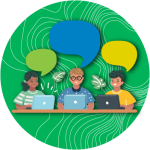
Have you ever read with your child and then fifteen minutes later they don’t remember what they read? Or even three pages later? Perhaps your child reads a passage for a homework assignment and yet doesn’t understand what they just read. Sound familiar?
You want to help your child with reading comprehension, but you don’t know where to start.
We can help!
We have 9 strategies to help with reading comprehension.
We’ll go over those strategies in in this series of blog posts. Your child might not need all nine. One might work magic! If you are a good reader and haven’t ever thought about how you read, you might be surprised to discover you use some or all of these strategies.
First, a reminder that good readers are not smarter than readers who struggle. Not at all!
Many highly intelligent and successful people have struggled with reading, and they became good readers. What they do, and what all good readers do, is develop habits and strategies that help them comprehend what they are reading and give them skills for when they get stuck.
Let's get started with Strategy #1.
Strategy #1: Prepare
Think of this like reading a map before taking a road trip. Your child needs to know where they are going and how to get there.
If possible, have your child choose a book that they are interested in and appeals to them. If they find books with long blocks of text intimidating, try shorter books or graphic novels. Don’t feel like there are certain books or types of books kids “should” be reading. All reading is beneficial, especially if they enjoy it.
Have your child take a moment to look at the book. Look at the cover. Flip through the pages. Read through the table of contents. Doing this will give your child (and you!) a brief idea of what kind of book it is (e.g. mystery, fantasy, adventure) and what the tone of the book will be. For example, the covers of the popular series, I Survived, are very different from Diary of a Wimpy Kid. A glance at the cover will tell you what you need to know about those books.
I Survived the Hindenburg Disaster, 1937
If your child is assigned a book for school, have them determine what kind of information they need. Is the assignment a book report? Do they need to write a summary? Is the reading assignment to find information on a topic? If so, then have your child identify what kind of information they need, and they will be better prepared to find it during reading. The more kids prepare ahead of time and know what they need from reading, the more it will help with comprehension.
Have your child ask these questions: What do I already know about this topic? If it is an author I am familiar with, what does that author write like? What can I expect? What is the purpose of reading this book/passage/article? All of these questions can help prepare their minds for reading.
These steps do not have to take a long time. As your kids are looking at the cover or flipping through the pages, they can quickly go over in their minds what they expect from the book. In time, it will become so natural they won’t even notice they are doing it.
There you have Strategy #1 to help your young reader get started on their way to becoming a more confident reader. We will go over the next strategy in another post.
Next time: Strategy #2: Making Connections / Background Knowledge
Visit Learn at Home for even more great resources, including:
- Free online tutoring
- Online tools available 24x7x365
- Recommended items from our collection that you can pick up curbside


